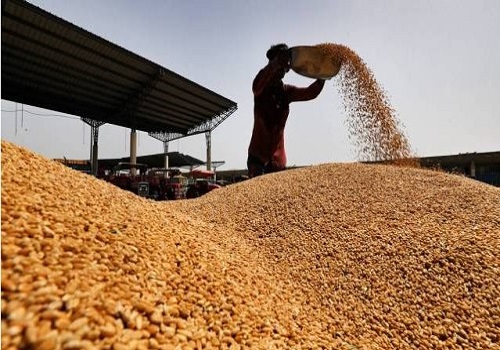Strategic Price Control: Evaluating the 2024-25 OMSS for Grains By Amit Gupta , Kedia Advisory

The Government of India has recently introduced a new policy for the sale of wheat, rice, and coarse grains in the open market through the Open Market Sale Scheme (Domestic) (OMSS (D)) for the year 2024-25. This policy, communicated through a formal directive dated July 9, 2024, outlines reserve prices and operational guidelines for offloading food grain stocks that are in excess of buffer stocking norms. The policy is set to be effective from August 1, 2024, to March 31, 2025, or until further orders are issued. This analytical report aims to evaluate the potential impacts of this policy on the prevailing price trends of these key agricultural commodities.
Key Provisions of the Policy
The OMSS(D) policy specifies different reserve prices and sale conditions for wheat, rice, and various coarse grains, ensuring a structured approach to market interventions.
For wheat, the reserve price is set at ?2325 per quintal for Fair Average Quality (FAQ) and ?2300 per quintal for Under Relaxed Specifications (URS) when sold to private parties through e-auction. The same price of ?2300 per quintal applies to sales made to Central Cooperative organizations like NAFED, NCCF, and Kendriya Bhandar, intended for retail under the 'Bharat' brand, as well as to community kitchens. An important condition is that no sale should occur during the procurement period in the procuring regions, with certain exceptions for sales to cooperative organizations.
For rice, the reserve price is uniformly set at ?2800 per quintal for private parties through e-auction and for direct sales to small private traders, entrepreneurs, and individuals. However, a lower price of ?2400 per quintal is established for sales to Central Cooperative organizations and community kitchens. This differential pricing is designed to support community services while maintaining market stability. The policy restricts additional subsidies from the Price Stabilization Fund (PSF) for specific transactions and dictates that e-auctions and direct sales occur only in deficit regions and only during non-procurement periods.
For coarse grains, the reserve prices are differentiated by grain type: ?2500 per quintal for Bajra, ?3846 per quintal for Ragi, ?3180 per quintal for Jowar, and ?2090 per quintal for Maize. These prices are set for sales through e-auction to private parties, with transportation costs to be added as applicable.
Impact Analysis
Wheat Market
The reserve prices for wheat, set slightly above the current Minimum Support Price (MSP), suggest a potential stabilizing effect on market prices. By offering wheat to private parties, cooperatives, and community kitchens at relatively uniform prices, the policy aims to prevent excessive price volatility. Additionally, by prohibiting sales during the procurement period in procuring regions, the policy seeks to ensure minimal disruption to the procurement process, thereby supporting farmers' incomes.
Another critical aspect is the provision allowing sales to Central Cooperative organizations in both procuring and consuming regions during the procurement period. This approach ensures a balanced distribution of wheat, preventing local shortages or surpluses that could destabilize prices. By strategically offloading stocks based on consultations between the Food Corporation of India (FCI) and the Department of Food and Public Distribution (DFPD), the policy maintains a steady supply that aligns closely with market demand.
Rice Market
The reserve price for rice is set higher for private parties (?2800 per quintal) compared to sales to cooperatives and community kitchens (?2400 per quintal). This pricing strategy may lead to a bifurcation in market prices, with lower prices available to consumers purchasing through cooperatives. Such a dual pricing system can help manage overall market stability by making rice more affordable through cooperative channels while maintaining competitive prices in the open market.
The policy’s restriction on e-auctions and direct sales to deficit regions during non-procurement periods ensures that the market supply is managed effectively, preventing price crashes during periods of high supply. Additionally, by limiting sales to non-surplus states, the policy ensures that states needing additional rice can meet their requirements without inflating prices in surplus regions. This strategic distribution helps maintain a balanced supply across different regions, preventing extreme price fluctuations.
Coarse Grains Market
For coarse grains, the reserve prices set by the policy are generally higher than their respective MSPs, reflecting an attempt to maintain farmer income levels while controlling market prices. By focusing on e-auctions for private parties, the policy introduces a competitive element to the market, potentially leading to better price discovery and efficiency. The transportation cost addition to reserve prices ensures uniform pricing across regions, preventing regional price disparities that could affect market stability.
The strategic reserve prices for Bajra, Ragi, Jowar, and Maize are likely to align market prices closely with these benchmarks. The controlled sale mechanism through e-auctions helps prevent sudden price fluctuations, supporting a steady market trend. By ensuring that sales occur only through competitive bidding, the policy promotes transparency and efficiency in the market, benefiting both producers and consumers.
Expected Market Trends
Wheat
Given the reserve prices and controlled sale conditions, wheat prices are expected to stabilize around the set benchmarks. The policy’s approach of allowing sales only in specific regions and periods ensures that the supply aligns closely with demand, preventing significant price drops. By maintaining a balance between procurement and open market sales, the policy supports market stability and farmer incomes.
Rice
Similar to wheat, rice prices are expected to reflect the reserve prices set by the policy. The differential pricing for cooperatives and private parties may create a dual pricing system, but this will help manage overall market stability by making rice more affordable through cooperative channels. The policy’s emphasis on restricting sales to deficit regions during non-procurement periods further stabilizes prices by managing supply effectively.
Coarse Grains
The prices of Bajra, Ragi, Jowar, and Maize are likely to align with the reserve prices set by the government. The controlled sale mechanism through e-auctions will help prevent sudden price fluctuations, supporting a steady market trend. By ensuring competitive bidding for sales, the policy promotes transparency and efficiency in the market, benefiting both producers and consumers.
Conclusion
The OMSS(D) policy for 2024-25 aims to stabilize the prices of wheat, rice, and coarse grains by setting strategic reserve prices and controlling the distribution of excess stocks. By focusing on balanced regional sales, minimizing procurement period disruptions, and ensuring cooperative participation, the policy seeks to maintain market equilibrium, support farmer incomes, and prevent excessive price volatility.
As the policy is implemented, continuous monitoring of its impact on market trends will be crucial to ensure its objectives are met effectively. By aligning market supply with demand and promoting competitive bidding, the policy fosters a more stable and efficient market environment. This, in turn, supports the broader goals of food security, farmer welfare, and economic stability.
Above views are of the author and not of the website kindly read disclaimer




















